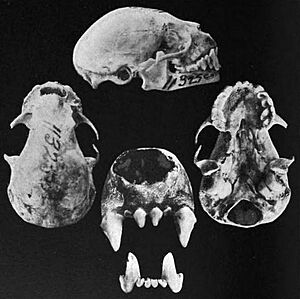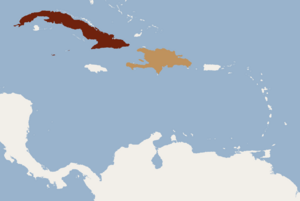Cuban fig-eating bat facts for kids
Quick facts for kids Cuban fig-eating bat |
|
|---|---|
 |
|
| Conservation status | |
| Scientific classification | |
| Genus: |
Phyllops
|
| Species: |
falcatus
|
 |
|
The Cuban fig-eating bat, also called the white-shouldered bat, (Phyllops falcatus) is a type of bat. It belongs to the Phyllostomidae family. You can only find this bat in the Caribbean region. It is the only living species in its group, called Phyllops. Scientists have found fossils of two other species, P. vetus and P. silvai.
Contents
Meet the Cuban Fig-Eating Bat
The Cuban fig-eating bat is a medium-sized bat. It has thick, soft, greyish-brown fur. The fur gets lighter on its belly. You can spot four small patches of pure white fur on its back. One patch is on each shoulder, and another is behind each ear.
Adult bats are about 5.5 to 6.5 centimeters (about 2 to 2.5 inches) long from head to body. Their wings can spread out 32 to 37 centimeters (about 12.5 to 14.5 inches) wide. They weigh between 16 and 23 grams (about 0.5 to 0.8 ounces). Female bats are usually bigger than males.
What Does It Look Like?
These bats have a very rounded head and a short nose. Their ears are round with a thick part called a tragus. They also have a wide, spear-shaped nose leaf on their face. This nose leaf has a pointed tip. It helps them make and direct their echolocation calls.
Their wings are quite large. They have unusually long thumbs on their wings. Most of the wing membrane is black. However, the part between their first and second fingers is clear, like glass. This clear part cannot be folded up like in most other bats. Their wings help them fly slowly but very skillfully. They can turn and move easily in the air. These bats do not have a visible tail.
Where Do Cuban Fig-Eating Bats Live?
Cuban fig-eating bats live across Cuba and its nearby smaller islands. You can also find them on Hispaniola, which includes Haiti and the Dominican Republic. They also live in the Cayman Islands. Once, a bat was seen far from its usual home in the Florida Keys.
Their Home Environment
These bats live in forests and park areas. They can be found from sea level up to 680 meters (about 2,230 feet) high. Their homes include both evergreen forests, where trees stay green all year, and deciduous woodlands, where trees lose their leaves.
Different Kinds of Cuban Fig-Eating Bats
Scientists recognize two main types, or subspecies, of the Cuban fig-eating bat. Sometimes, people have thought these two types might be separate species.
- P. f. falcatus - This type lives in Cuba and the Cayman Islands.
- P. f. haitiensis - This type lives on the island of Hispaniola.
How Do They Live?
Cuban fig-eating bats are nocturnal, meaning they are active at night. Despite their name, scientists do not know much about what they eat. However, some studies have found Cecropia tree seeds in their droppings. This suggests they might eat these seeds.
During the day, these bats rest. They hide in thick leaves in groups of three to five bats. They are a common meal for local barn owls.
Family Life
These bats do not seem to have a specific time of year when they have babies. They likely can have babies several times throughout the year. Most observations show that there are more female bats than male bats in certain areas. This might mean that one male bat mates with several female bats.
Bat Calls
Cuban fig-eating bats use animal echolocation to find their way around and hunt. This means they send out sounds and listen for the echoes. Their echolocation calls have a very wide range of sound. The first part of their call sweeps down from a high sound to a lower one. Each call lasts for about 4 to 5 milliseconds. There is a short break of about 110 milliseconds between each sound pulse.


